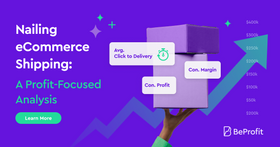Is Dropshipping Still Profitable in 2022 or Will You Lose Money?
Published August 15, 2022

Dropshipping has emerged as one of the most popular business models for e-commerce store owners in the digital age. With a dropshipping strategy, business leaders list products from manufacturing partners on their websites. Whenever an order is placed, it’s automatically transferred to the dropshipping vendor, who deals with fulfilling the order.
Dropshipping allows entrepreneurs to enter the e-commerce landscape without the common expenses and challenges associated with holding and shipping inventory. However, while dropshipping is great for improving the e-commerce order fulfillment process, it has its challenges too.
As dropshipping apps and tools become more popular in 2022, it’s worth asking whether this model is still a profitable strategy for your business. Read on to find the answer to this and the challenges faced by potential dropshippers in 2022.
The Challenges Faced by Dropshippers in 2022
Disrupted Supply Chains
One of the most significant issues this year has been the disruption in supply chains and logistics around the world. A disruption in the dropshipping supply chain could leave customers waiting weeks or months for an order, which damages a brand’s reputation.
Rising Customer Expectations
Post-pandemic customers are less likely to settle for slow delivery times and unpredictable product quality. This means companies in the dropshipping industry need to work harder to find suppliers who can deliver products fast and provide consistently great items.
Rising Competition
Another major issue dropshippers have faced in 2022 is the struggle to differentiate themselves from other merchants. With various forms of Shopify, Wix, and Amazon dropshipping for beginners now available, the barrier to entry for this mode of selling is lower than ever. This means competition is rising, making it much harder for companies to find unique products to set themselves apart from the crowd.
Additionally, you'll also have to compete with different shipping costs, product qualities, and e-commerce ads.
Profitability of Dropshipping in 2022
Though dropshipping professionals have seen a number of challenges during 2022, this doesn’t mean the potential of the market has diminished. According to some studies, the dropshipping market is set to reach a value of over $621 million by 2028, growing at a rate of 20.7% CAGR.
Since the pandemic, more customers have begun shopping almost exclusively online. By the end of 2022, e-commerce is set to account for around 20.4% of all global sales. Even as the impact of the pandemic damages the logistics and supply chain landscape, the opportunity for e-commerce sellers is growing astronomically. This means dropshipping professionals have plenty of chances to profit.
Can Dropshippers Cope With the Challenges?
Indeed, dropshipping companies may even be more suited to withstanding the complications of the problematic logistics environment than most. After all, with the best Shopify dropshipping apps and similar tools, business leaders can quickly and easily find new suppliers if their chosen vendor isn’t able to deliver the products they need.
Interest in dropshipping is growing too. The number of people searching the word “dropshipping” has increased exponentially over the last couple of years. Plus, virtually every e-commerce site-building tool now comes with integrations and apps to make dropshipping easier.
Despite the challenges, dropshipping companies aren’t just surviving in 2022; they’re thriving. Today, dropshipping and e-commerce sales are accelerating towards a value of $5.49 trillion, and they’re growing at a consistent rate of around 10.98% per year.
Evolution of Dropshipping Best Practices
Though it’s clear that dropshipping still has significant potential in 2022, companies do need to make sure they’re approaching this landscape carefully. The challenges of the evolving e-commerce environment have led to the adoption of new best practices, such as:
- Leveraging the right dropshipping tools Companies are investing extra time and effort into ensuring they have the right tools in place for dropshipping. This could include comparing Wix vs Shopify for dropshipping or exploring different apps in each e-commerce ecosystem to ensure you’re getting access to the right suppliers.
- Putting the customer first As customer expectations continue to rise, companies in the dropshipping environment need to make sure they’re prioritizing “CX”. This means implementing new strategies to deliver products faster and making sure the right policies are in place to respond to queries at scale.
- Increasing vendor relationships In an unpredictable logistics environment, it’s often a good idea to have multiple relationships with different vendors. Drosphippers are beginning to form connections with a wider selection of suppliers, so they can rest assured they’ll always have access to the inventory they need.
- Leveraging analytics To differentiate and stay one step ahead of the competition in the dropshipping world, companies need to keep a close eye on business insights. Brands are now using more tools to keep track of their most popular products and boost customer experiences.
- Brand marketing There are many different ways to market your brand, from advertising on Snapchat and Facebook, to using influencer marketing, and much more.
Dropshipping Isn’t Dead
Although dropshippers, like all e-commerce business leaders, have experienced some challenges in recent years, there’s still exceptional potential for growth in this environment. Companies capable of leveraging the dropshipping environment correctly can still make a fantastic profit in the years to come.







